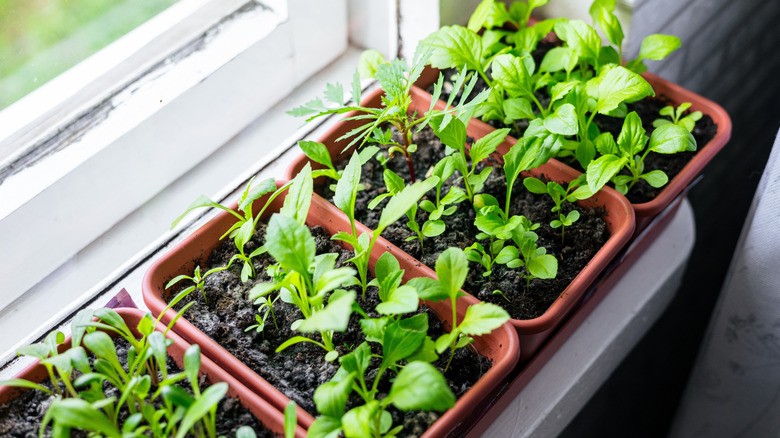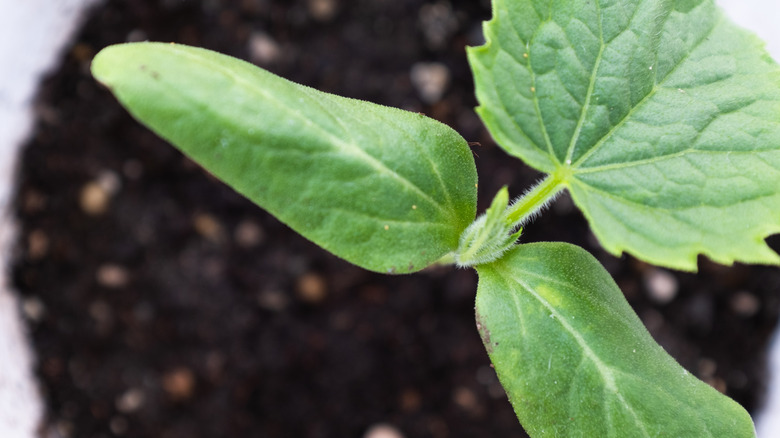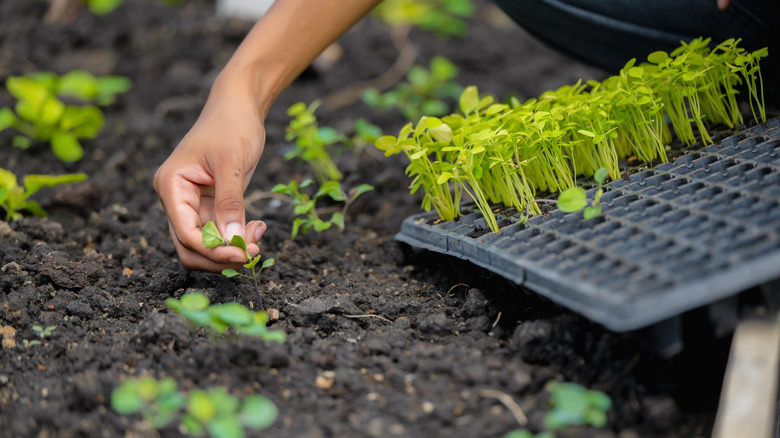Gardeners Swear By This Simple Tip To Time Transplants Perfectly
After you've successfully germinated your seedlings, you're up against a new hurdle: transplanting them into your outdoor garden. Proper timing is essential here, and that doesn't just mean the date on the calendar. Rather, it's important to evaluate the growth of the seedlings themselves. Transplant too soon and the seedlings may get transplant shock. Transplant too late and they may outgrow their trays and become root-bound.
The best time to transplant seedlings is right after they develop their first set of "true leaves," said Nicole Dillon, micro-flower farmer and owner of Breemar Flower Farm in Ashland, Virginia. The first leaves that appear on seedlings are not true leaves, but "cotyledon leaves," which later fall off — like the plant equivalent of baby teeth.
"Cotyledon leaves are not true leaves and can look quite different from the plant's actual leaves," Dillon exclusively told House Digest, adding, "Cotyledon leaves use energy that was already stored within the seed and are kind of a stopgap between a plant emerging and having time to photosynthesize its first true set of leaves." These true leaves look like "tiny versions of the mature plant's leaves," Dillon explained. Without true leaves, the seedlings won't be able to thrive outdoors for long.
True leaves mean your seedlings are finally ready
As Dillon explained exclusively to House Digest, "You want the plant to have at least one true set of leaves before moving them out to the garden because cotyledons don't have any extra energy to help a plant survive." Some cotyledons can photosynthesize, but not as well as true leaves, and they're not designed to sustain the plant long-term. But after a plant has true leaves, it can effectively keep itself alive while acclimating to the outdoors. Your seedlings' progress beneath the surface is equally important. Dillon explained that "true leaves indicate that a root system is developing."
Generally, true leaves develop on seedlings about seven to 14 days after sprouting, but it depends on the growing conditions. If your seedlings seem to be taking longer than expected, our expert recommends considering how much light and water they're getting. Bright light is a must, but she says water is the most difficult part: "Seedlings need to stay moist, but a dry/moist environment cycle is a good idea to prevent fungal diseases; be consistent with watering." Dillon also shared that "some seedlings are very temperature or daylight sensitive."
What to do after true leaves appear
Once you see true leaves, go ahead and begin the transplanting process. "Don't worry about their size so much," Dillon told House Digest exclusively. "If there are true leaves, and the plant has been properly hardened off, size doesn't really matter. Get it in the place it is meant to live its life." Allowing your seedlings to stay in their trays for too long can actually be detrimental to their health due to the lack of nutrients and root space. "As an example, I don't allow sunflower seedlings to sit in a tray for more than two weeks. If I let them go past two weeks, I will see a difference in quality," Dillon stated.
Skipping the hardening off process is one common mistake gardeners make when transplanting seedlings. "Be sure to harden it off for up to seven days before transplanting to avoid shock due to extreme weather conditions," our expert advised. Place the seedlings outdoors in a sheltered location initially, gradually increasing the amount of sunlight. Dillon also recommended planting seedlings "early in the morning or late in the evening," planting in moist soil, and watering the seedlings well.


